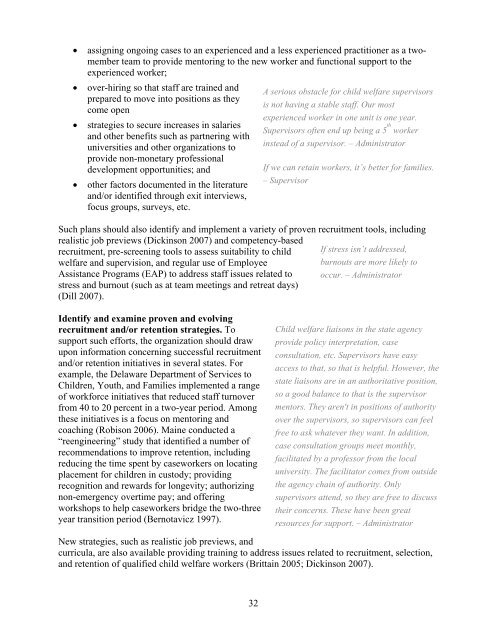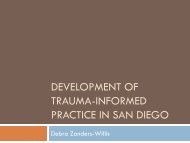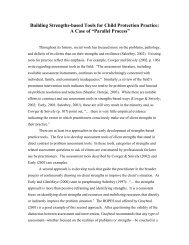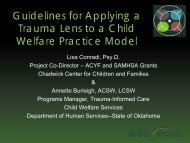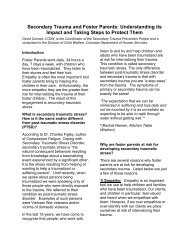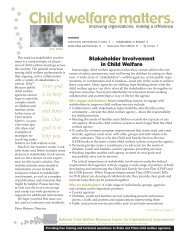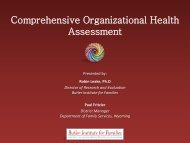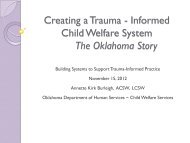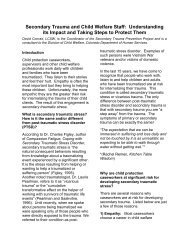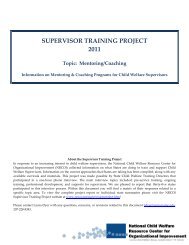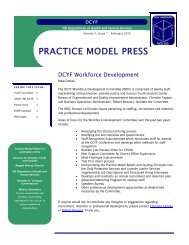Building a Model and Framework for Child Welfare Supervision
Building a Model and Framework for Child Welfare Supervision
Building a Model and Framework for Child Welfare Supervision
You also want an ePaper? Increase the reach of your titles
YUMPU automatically turns print PDFs into web optimized ePapers that Google loves.
• assigning ongoing cases to an experienced <strong>and</strong> a less experienced practitioner as a twomember<br />
team to provide mentoring to the new worker <strong>and</strong> functional support to the<br />
experienced worker;<br />
• over-hiring so that staff are trained <strong>and</strong> A serious obstacle <strong>for</strong> child welfare supervisors<br />
prepared to move into positions as they<br />
is not having a stable staff. Our most<br />
come open<br />
experienced worker in one unit is one year.<br />
• strategies to secure increases in salaries<br />
Supervisors often end up being a 5 th worker<br />
<strong>and</strong> other benefits such as partnering with<br />
universities <strong>and</strong> other organizations to<br />
instead of a supervisor. – Administrator<br />
provide non-monetary professional<br />
development opportunities; <strong>and</strong><br />
If we can retain workers, it’s better <strong>for</strong> families.<br />
• other factors documented in the literature<br />
<strong>and</strong>/or identified through exit interviews,<br />
focus groups, surveys, etc.<br />
– Supervisor<br />
Such plans should also identify <strong>and</strong> implement a variety of proven recruitment tools, including<br />
realistic job previews (Dickinson 2007) <strong>and</strong> competency-based<br />
recruitment, pre-screening tools to assess suitability to child If stress isn’t addressed,<br />
welfare <strong>and</strong> supervision, <strong>and</strong> regular use of Employee<br />
burnouts are more likely to<br />
Assistance Programs (EAP) to address staff issues related to occur. – Administrator<br />
stress <strong>and</strong> burnout (such as at team meetings <strong>and</strong> retreat days)<br />
(Dill 2007).<br />
Identify <strong>and</strong> examine proven <strong>and</strong> evolving<br />
recruitment <strong>and</strong>/or retention strategies. To<br />
support such ef<strong>for</strong>ts, the organization should draw<br />
upon in<strong>for</strong>mation concerning successful recruitment<br />
<strong>and</strong>/or retention initiatives in several states. For<br />
example, the Delaware Department of Services to<br />
<strong>Child</strong>ren, Youth, <strong>and</strong> Families implemented a range<br />
of work<strong>for</strong>ce initiatives that reduced staff turnover<br />
from 40 to 20 percent in a two-year period. Among<br />
these initiatives is a focus on mentoring <strong>and</strong><br />
coaching (Robison 2006). Maine conducted a<br />
“reengineering” study that identified a number of<br />
recommendations to improve retention, including<br />
reducing the time spent by caseworkers on locating<br />
placement <strong>for</strong> children in custody; providing<br />
recognition <strong>and</strong> rewards <strong>for</strong> longevity; authorizing<br />
non-emergency overtime pay; <strong>and</strong> offering<br />
workshops to help caseworkers bridge the two-three<br />
year transition period (Bernotavicz 1997).<br />
<strong>Child</strong> welfare liaisons in the state agency<br />
provide policy interpretation, case<br />
consultation, etc. Supervisors have easy<br />
access to that, so that is helpful. However, the<br />
state liaisons are in an authoritative position,<br />
so a good balance to that is the supervisor<br />
mentors. They aren't in positions of authority<br />
over the supervisors, so supervisors can feel<br />
free to ask whatever they want. In addition,<br />
case consultation groups meet monthly,<br />
facilitated by a professor from the local<br />
university. The facilitator comes from outside<br />
the agency chain of authority. Only<br />
supervisors attend, so they are free to discuss<br />
their concerns. These have been great<br />
resources <strong>for</strong> support. – Administrator<br />
New strategies, such as realistic job previews, <strong>and</strong><br />
curricula, are also available providing training to address issues related to recruitment, selection,<br />
<strong>and</strong> retention of qualified child welfare workers (Brittain 2005; Dickinson 2007).<br />
32


